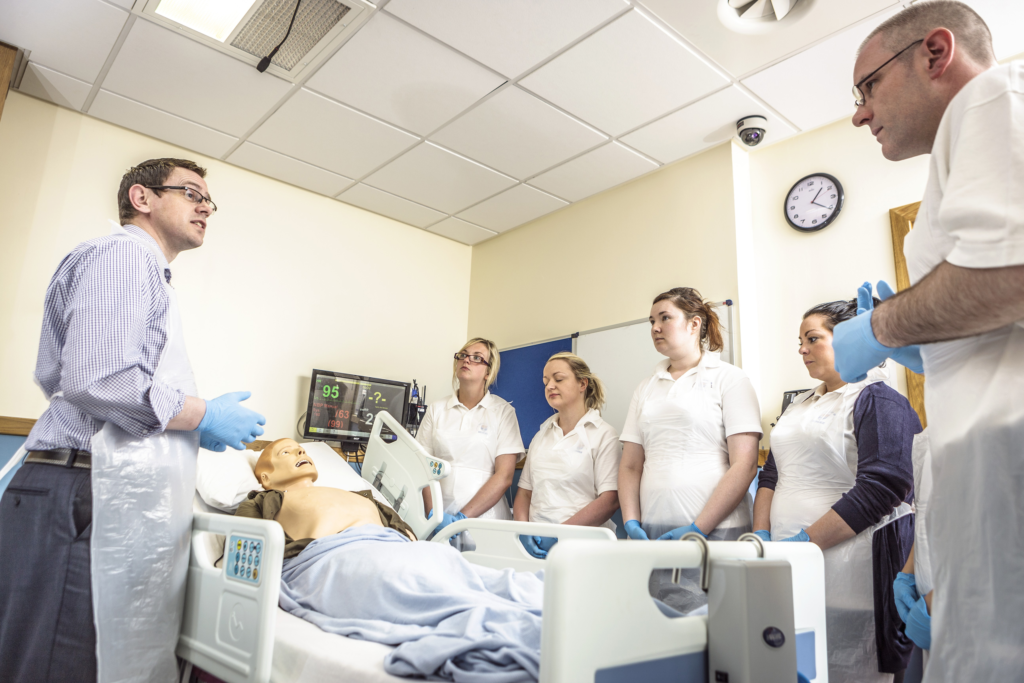In the ever-evolving field of healthcare, the need for highly competent nursing professionals is paramount. Nursing competency is not only a measure of theoretical knowledge but also a reflection of a nurse’s ability to apply that knowledge in real-world scenarios, make critical decisions, and provide high-quality patient care. Traditional nursing education, which often relies heavily on classroom instruction and limited clinical exposure, may not fully prepare students for the complexities of modern healthcare. This is where realistic patient care simulations come into play, offering a powerful tool for bridging the gap between theory and practice. In this blog, we explore the impact of realistic patient care simulations on nursing competency, focusing on aspects that are often overlooked in traditional discussions.
The growing importance of nursing competency
Nursing competency encompasses a wide range of skills, including clinical knowledge, critical thinking, decision-making, communication, and the ability to work effectively in a multidisciplinary team. Competency is crucial for ensuring patient safety, improving outcomes, and reducing the incidence of medical errors. According to the institute of medicine (iom), medical errors are a leading cause of death in the united states, with an estimated 98,000 deaths annually attributed to preventable errors, many of which involve nursing care.
Given these statistics, the importance of developing nursing competency cannot be overstated. However, achieving this level of competency requires more than just textbook learning. It demands hands-on practice, real-time decision-making, and the ability to apply knowledge in dynamic, high-pressure environments. Realistic patient care simulations provide an ideal platform for developing these essential skills.
What are realistic patient care simulations?
Realistic patient care simulations involve the use of high-fidelity mannequins, standardized patients (actors trained to portray real patients), or virtual simulations to replicate real-life clinical scenarios. These simulations are designed to mimic the complexities of actual patient care, allowing nursing students to practice a wide range of skills, from basic procedures to advanced critical thinking and problem-solving. Simulations can range from routine tasks, such as administering medications, to high-stakes scenarios, such as managing a cardiac arrest or responding to a mass casualty event.
The impact of realistic simulations on nursing competency
1. Enhancing clinical skills and knowledge application
One of the most significant benefits of realistic patient care simulations is the opportunity to apply theoretical knowledge in a practical setting. This hands-on practice is essential for developing clinical skills and ensuring that nursing students are prepared to perform procedures safely and effectively.
Skill mastery through repetition: simulations allow students to practice procedures repeatedly until they achieve proficiency. This repetition is particularly important for mastering complex or high-risk tasks, such as iv insertion, wound care, or medication administration. According to a study published in nurse education today, students who engaged in realistic simulations demonstrated a 35% improvement in clinical skill proficiency compared to those who received only traditional classroom instruction.
Bridging the theory-practice gap: nursing students often struggle to translate theoretical knowledge into practical application. Realistic simulations help bridge this gap by providing a safe environment where students can apply what they have learned in the classroom to real-world scenarios. This practice not only reinforces their understanding but also enhances their ability to think critically and make informed decisions under pressure.
2. Developing critical thinking and decision-making skills
Nurses are often required to make quick, accurate decisions in high-pressure situations. Critical thinking and decision-making are therefore key components of nursing competency. Realistic patient care simulations are uniquely suited to developing these skills.
Real-time decision-making: in a simulation, students are placed in scenarios where they must assess a patient’s condition, prioritize interventions, and make decisions in real-time. This experience is invaluable for developing the ability to think on their feet and respond effectively to changing conditions. A study in the journal of nursing education found that students who participated in realistic simulations were 30% more confident in their decision-making abilities compared to those who only engaged in traditional learning methods.
Learning from mistakes: mistakes are an inevitable part of the learning process, but in real clinical settings, they can have serious consequences. Simulations provide a safe space for students to make mistakes, receive feedback, and learn from their errors without putting patients at risk. This iterative process helps students refine their critical thinking skills and develop sound clinical judgment.
3. Improving communication and teamwork
Effective communication and teamwork are essential for providing high-quality patient care, particularly in complex or emergency situations. Realistic patient care simulations offer a platform for nursing students to practice these skills in a controlled, yet dynamic environment.
Interprofessional collaboration: many simulations are designed to mimic real-world healthcare settings, where nurses must work closely with physicians, pharmacists, respiratory therapists, and other healthcare professionals. These interprofessional simulations help students understand the roles and responsibilities of different team members and develop the communication skills needed to collaborate effectively. Research in the journal of interprofessional care found that nursing students who participated in interprofessional simulations were 28% more likely to engage in effective teamwork in clinical practice.
Patient communication: communication with patients is another critical aspect of nursing care. Simulations that include standardized patients allow students to practice patient-centered communication, such as explaining procedures, obtaining informed consent, and providing emotional support. This practice is essential for building the trust and rapport needed to deliver compassionate, patient-centered care. A study in patient education and counseling found that students who practiced patient communication in simulations were 25% more effective in real patient interactions.
4. Enhancing cultural competence and sensitivity
In today’s diverse healthcare environment, cultural competence is an essential component of nursing competency. Nurses must be able to provide care that is respectful of and responsive to the cultural beliefs, practices, and needs of patients from diverse backgrounds. Realistic simulations can be designed to include culturally diverse patient scenarios, helping students develop the skills needed to provide culturally competent care.
Culturally tailored simulations: simulations can be tailored to reflect the cultural diversity of the patient population, including scenarios that require students to navigate language barriers, cultural beliefs about healthcare, and differing expectations about patient-provider interactions. By practicing in these scenarios, students can develop the cultural sensitivity needed to provide equitable and effective care. A study in bmc nursing found that nursing students who participated in culturally tailored simulations were 29% more likely to provide culturally competent care in clinical practice.
Addressing health disparities: simulations can also be used to raise awareness of health disparities and the social determinants of health that impact patient outcomes. By including scenarios that address issues such as access to care, socioeconomic status, and health literacy, simulations can help students develop a deeper understanding of the challenges faced by vulnerable populations and the role of nurses in addressing these disparities.
5. Building confidence and reducing anxiety
The transition from nursing student to practicing nurse can be anxiety-provoking, particularly when students feel unprepared for the realities of clinical practice. Realistic simulations help build the confidence needed to make this transition successfully.
Confidence building through practice: by allowing students to practice in a realistic, yet controlled environment, simulations help build the confidence needed to perform tasks competently in a real clinical setting. A study in simulation in healthcare found that students who participated in realistic simulations reported a 40% increase in confidence levels compared to those who only received traditional training.
Reducing performance anxiety: the fear of making mistakes in front of peers or instructors can increase anxiety and hinder learning. Simulations provide a low-pressure environment where students can practice without the fear of judgment, allowing them to focus on skill development and learning from their experiences.
6. Supporting lifelong learning and professional development
The benefits of realistic patient care simulations extend beyond initial nursing education. These simulations can be valuable tools for continuing education, professional development, and maintaining competency throughout a nurse’s career.
Continuing education and skill maintenance: even experienced nurses need to maintain their skills and stay current with best practices. Realistic simulations can be used in continuing education programs to help nurses refresh their knowledge, practice new techniques, and maintain competency in high-risk or low-frequency procedures. According to the american nurses association (ana), continuing education programs that include simulation-based training improve knowledge retention and clinical performance by 30%.
Adaptation to new technologies and practices: healthcare is constantly evolving, with new technologies, treatments, and care models emerging regularly. Realistic simulations provide a platform for nurses to learn and practice new skills, ensuring that they remain competent and confident in their ability to deliver high-quality care in a rapidly changing environment.
The future of realistic patient care simulations: technology and innovation
As technology continues to advance, the potential for realistic patient care simulations in nursing education is expanding. Innovations such as virtual reality (vr), augmented reality (ar), and artificial intelligence (ai) are being integrated into simulation training, offering even more immersive and personalized learning experiences.
Virtual reality (vr) and augmented reality (ar): vr and ar technologies can create highly immersive simulation environments, where students can practice nursing skills in a fully interactive 3d space. These technologies offer a more engaging and informative experience, helping students to better understand complex clinical scenarios and improve their skills.
Artificial intelligence (ai): ai-driven simulations can adapt to individual students’ learning needs, offering personalized feedback and adjusting the complexity of scenarios based on their performance. This adaptability makes ai a valuable tool for enhancing the effectiveness of simulation training.
A report by gartner predicts that the integration of vr, ar, and ai into nursing simulations could improve learning outcomes by up to 50%, offering a more comprehensive and engaging educational experience.
Conclusion
Realistic patient care simulations are transforming nursing education by providing a powerful tool for developing the skills, knowledge, and confidence needed to deliver high-quality patient care. By offering hands-on practice in a controlled environment, these simulations help bridge the gap between theory and practice, enhance critical thinking and decision-making, improve communication and teamwork, and build cultural competence. As technology continues to advance, the potential for even more effective and immersive simulation training will grow, ensuring that nursing professionals are well-equipped to meet the challenges of modern healthcare. Ultimately, the integration of realistic patient care simulations into nursing education can lead to better patient outcomes and a more competent, confident nursing workforce.

